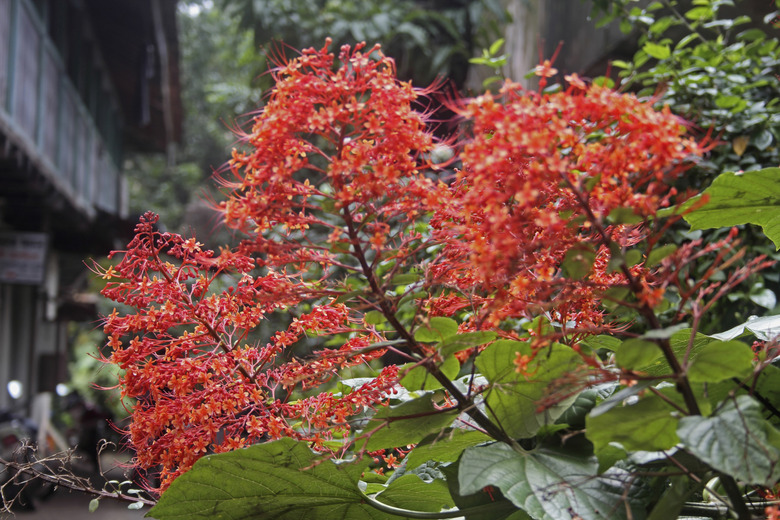How To Care For A Pagoda Plant
Pagoda plant (Clerodendrum paniculatum) earned its common name because of the tiered, pyramidal shape of its flower clusters, which stand out against its large, heart-shaped leaves. It grows in U.S. Department of Agriculture plant hardiness zones 8 through 11, where its equally ornamental foliage and flowers brighten gardens all year. Pagoda plant requires year-round care to maintain its good looks and long-term health. Its care requirements vary by season but decrease significantly in winter.
Seasonal Watering
A pagoda plant's water needs fluctuate significantly during the year. In summer, it needs consistently moist soil and should be watered weekly or whenever the soil dries out completely on the surface. A potted pagoda plant will quickly deplete soil moisture and may need to be watered several times each week, especially if it is in an unglazed clay pot. Water until the soil feels moist in the top 2 inches, or until water trickles from the pot's drainage holes. Only use pots with drainage holes so the plant doesn't sit in soggy soil. In winter, water only if no rain falls for longer than one week or if the plant appears slightly wilted.
Fertilizer Needs
A pagoda plant is a moderately heavy feeder during summer, especially if it is in full sun. In shade, feed a pagoda plant once every two weeks with soluble fertilizer with an N-P-K number of 15-15-15 or 12-12-12. Increase the frequency to weekly for a plant in full sun. Dissolve 1/2 teaspoon of fertilizer in 1 gallon of water and apply the solution to wet soil around the base of the plant. Don't fertilize in winter to allow the pagoda plant to rest. Resume feeding in spring.
Pruning and Grooming
A pagoda plant will grow quickly in summer, which means it may crowd out less assertive plants. Prune it to restrict its size and encourage better blooming and denser foliage. Prune in summer after the last flowers have faded. Snip off any spent flowers and trim back the entire plant by up to one-half, is you wish. Before pruning, soak your shears in a disinfecting solution for five minutes, then rinse and wipe them thoroughly. Use 1 part pine oil cleaner and 3 parts water or full-strength household disinfectant as the solution.
Potential Problems
Pests, including aphids, whiteflies and spider mites, often trouble a pagoda plant, causing damage that ranges from cosmetic to catastrophic. Early detection is key to ensuring the survival of the plant, so routinely monitor it for signs of bugs such as eggs on the undersides of the leaves, honeydew and abnormally yellow leaves. Treat infestations with an insecticidal soap solution. Mix 5 tablespoons of insecticidal soap in 1 gallon of water in a pump sprayer. Saturate the foliage every four to seven days, preferably when the weather is still and cool. Although insecticidal soap is nontoxic, wear goggles and a face mask to protect your mucous membranes. Rinse off the plant two to three hours after each treatment to prevent leaf damage.
